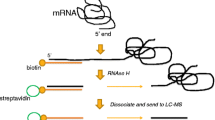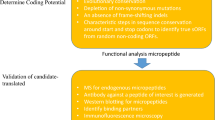Summary
The expression of the chloramphenicol (Cm) —inducible Cm acetyltransferase gene (cat) of the staphylococcal plasmid pUB112 is regulated at the translational level. The leader mRNA preceding the cat coding sequence can form a stable hairpin structure, in which the cat Shine-Dalgarno sequence is masked. Previous work showed that translation of a short leader peptide terminating within the stem of the inhibitory secondary structure is required for basal Cm acetyltransferase (CAT) synthesis and its inducibility. In the present study we shortened this leader peptide by introducing ochre codons in its coding sequence and found that synthesis of the N-terminal part of the leader peptide, terminating directly 5′ to the stem, is sufficient to mediate basal and inducible CAT synthesis. Amino acid substitution in this region of the leader peptide abolished inducibility. We suggest that the 5′ region of the leader peptide coding sequence specifies a particularly Cm-sensitive translation that represents the Cm-sensor mechanism for cat gene induction.
Similar content being viewed by others
References
Ambulos NP, Mongkolsuk S, Kaufman JD, Lovett PS (1985) Chloramphenicol-induced translation of the cat-86 gene requires two cis-acting regulatory regions. J Bacteriol 164:696–703
Bradford MM (1976) A rapid and sensitive method for the quantitation of microgram quantities of protein utilizing the principle of protein dye binding. Anal Biochem 72:248–254
Brückner R, Matzura H (1985) Regulation of the inducible chloramphenicol acetyltransferase gene of the Staphylococcus aureus plasmid pUB112. EMBO J 4:2295–2300
Brückner R, Zyprian E, Matzura H (1984) Expression of a chloramphenicol-resistance determinant carried on hybrid plasmids in gram-positive and gram-negative bacteria. Gene 32:151–160
Brückner R, Dick T, Matzura H (1987) Dependence of expression of an inducible Staphylococcus aureus cat gene on the translation of its leader sequence. Mol Gen Genet 207:486–491
Drainas D, Kalpaxis DL, Coutsogeorgopoulos C (1987) Inhibition of ribosomal peptidyltransferase by chloramphenicol. Eur J Biochem 164:53–58
Dubnau D (1984) Translational attenuation: The regulation of bacterial resistance to macrolide-lincosamide-streptogramin B antibiotics. CRC Crit Rev Biochem 16:103–132
Duvall EJ, Lovett PS (1986) Chloramphenicol induces translation of the mRNA for a chloramphenicol-resistance gene in Bacillus subtilis. Proc Natl Acad Sci USA 83:3939–3943
Duvall EJ, Ambulos NP, Lovett PS (1987) Drug-free induction of a chloramphenicol acetyltransferase gene in Bacillus subtilis by stalling ribosomes in a regulatory leader. J Bacteriol 169:4235–4241
Gale EF, Cundliffe E, Reynolds PE, Richmond MH, Waring MJ (1981) The molecular basis of antibiotic action. Wiley and Sons, London, pp 460–468
Gryczan TJ, Dubnau D (1978) Construction and properties of chimeric plasmids in Bacillus subtilis. Proc Natl Acad Sci USA 75:1428–1432
Leonhardt H, Alonso JC (1988) S1 mapping of the pC194 encoded chloramphenicol acetyltransferase gene in B. subtilis. Nucleic Acids Res 16:1618
Messing JM (1983) New M13 vectors for cloning. Methods Enzymol 101:20–78
Messing JM, Vieira J (1982) A new pair of M13 vectors for selecting either strand of double-digest restriction fragments. Gene 19:269–276
Nakamaye KL, Eckstein F (1986) Inhibition of restriction endonuclease Ncil cleavage by phosphorothioate groups and its application to oligonucleotide-directed mutagenesis. Nucleic Acids Res 14:9679–9698
Narayanan CS, Dubnau D (1987) Demonstration of erythromycin-dependent stalling of ribosomes on the ermC leader transcript. J Biol Chem 262:1766–1771
Sanger F, Nicklen S, Coulson AR (1977) DNA sequencing with chain-terminating inhibitors. Proc Natl Acad Sci USA 74:5463–5467
Shaw WV (1975) Chloramphenicol acetyltransferase from chloramphenicol-resistant bacteria. Methods Enzymol 43:737–755
Shaw WV (1983) Chloramphenicol acetyltransferase: enzymology and molecular biology. CRC Crit Rev Biochem 14:1–46
Viret JF, Alonso JC (1987) A new mutator strain of Bacillus subtilis. Mol Gen Genet 208:353–356
Weisblum B (1983) Inducible resistance to macrolides, lincosamides and streptogramin type-B antibiotics: The resistance phenotype, its biological diversity, and structural elements that regulate expression. In: Beckwith J, Davies J, Gallant JA (eds) Gene function in procaryotes. Cold Spring Harbor Laboratory Press, New York, pp 91–121
Zoller MJ, Smith M (1983) Oligonucleotide-directed mutagenesis of DNA fragments cloned into M13 vectors. Methods Enzymol 100:468–500
Zyprian E (1987) Analyse von Genexpressionssignalen in dem grampositiven Kanamycinresistenzplasmid pUB110, Entwicklung eines grampositiven Expressionsvectorsystems und Charakterisierung des induzierbaren Chloramphenicol Acetyltransferase Gens auf dem Staphylococcus aureus Plasmid pC223. Thesis, Heidelberg
Author information
Authors and Affiliations
Additional information
Communicated by W. Goebel
Rights and permissions
About this article
Cite this article
Dick, T., Matzura, H. Positioning ribosomes on leader mRNA for translational activation of the message of an inducible Staphylococcus aureus cat gene. Mol Gen Genet 214, 108–111 (1988). https://doi.org/10.1007/BF00340187
Received:
Issue Date:
DOI: https://doi.org/10.1007/BF00340187




